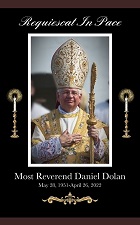Mary's Association with Jesus in the Redemption
The Church calls Mary Mother of the Saviour as well as Mother of God. In the Litany of Loreto, for example, after the invocations, Holy Mother of God and Mother of the Creator, we find the other, Mother of the Saviour, pray for us. Though some have thought the contrary (1) the fact of these two titles is no reason for believing that Mariology labours under the defect of a duality of distinct principles: "Mother of God" and "Mother of the Saviour, who Is associated with His redemptive work." Mariology is a unity, for Mary is "Mother of God the Redeemer or the Saviour." In much the same way the two mysteries of the Incarnation and the Redemption do not take away from the unity of Christology, for its central point is the redemptive Incarnation. The motive of the Incarnation is sufficiently indicated in the Creed which says that the Son of God came down from heaven for our salvation.
(1) Rev. Professor Bittremieux in De supremo principio Mariologiae, Eph. theol. Lovan., 1931, though he does not deny that a sense Mariology can be reduced to one principle, insists rather on quaiity. As against this ef. Merkelbach, Mariologia, pp. 91 sqq.
Mary gave her consent to the redemptive Incarnation when, on the day of the Annunciation, the angel said to her: "Thou shalt conceive in thy womb, and shalt bring forth a son; and thou shalt call his name Jesus" - the name to be given to her Son meaning "Saviour." Mary was not ignorant of the Messianic prophecies - most particularly those of Isaias - which foretold the redemptive sufferings of the promised Saviour. Thus, when she uttered her flat she accepted in advance for herself and for her Son all the sufferings which the redemption would involve.
She learned something still more explicit about them a few days later when Simeon spoke to her: "Behold this child is set for the fall, and for the resurrection of many in Israel, and for a sign which shall be contradicted; And thy own soul a sword shall pierce." A little earlier he had spoken of Jesus as "... thy salvation, which thou hast prepared before the face of all peoples." Mary, we are told, kept all these words in her heart. The divine plan became gradually clearer to her contemplative faith, lit up as it was by the illumination of the gift of understanding.
Mary therefore became freely Mother of the Redeemer in His role of Redeemer; she grew in her appreciation of the fact that the Son of God became man for our salvation. She united herself to Jesus as only a mother, and a very holy mother, could in perfect oneness of love for God and souls. That was her way of fulfilling the great precept of the law - and what more perfect way could there be? Tradition is clear on Mary's union with the Redeemer; it never tires of repeating that as Eve was united to the first man in the work of perdition Mary was united to the Redeemer in the work of redemption.
How Was the Mother of the Redeemer to be Associated with His Work?
According to what the Fathers of the Church tell us about Mary as the New Eve whom many saw foretold in the words of Genesis, it is common and certain doctrine, and even fidei proxima, that the Blessed Virgin, Mother of the Redeemer, is associated with Him in the work of redemption as secondary and subordinate cause, just as Eve was associated with Adam in the work of man's ruin (3).
(3) Many Fathers, followed by many theologians, have noted that if Eve alone had sinned there would have been no original sin, and if Mary alone had given her consent without Jesus there would have been no redemption.
Clearly, Mary is not the principal and perfective cause of the Redemption: she could not redeem us in justice, de condigno, since for that a theandric act of infinite value which could belong only to an incarnate Divine Person required. Bur she is really a secondary cause of salvation, dispositive, and subordinate to Jesus. She is said to be subordinated to Jesus not merely in the sense that she is inferior to Him, but also in the sense that she concurred in saving us by a grace which proceeded from His merits, and therefore acted in Him, with Him, and by Him. We must never forget that Jesus is the Universal Mediator. He redeemed Mary by preserving her from original sin. Similarly, it is through Him that she contributed to saving us. She is not the perfective cause of salvation, but a dispositive one, disposing us to undergo the action of her Son, Who it is achieves our salvation and is our Redeemer.
Mary's association with Jesus in the redemption is therefore not like that of the Apostles, but is something still more intimate. That is what St. Albert the Great formulated so happily when he said: "The Blessed Virgin Mary was chosen by God not to be His minister but to be His consort and His helper - in consortium et adjutorium - according, to the words of Genesis: Let us make him a help like to himself" (Mariale, q.42).
We can now see that the unity of Mariology does not suffer from the defect of having two distinct principles. There is one principle which dominates it: Mary is Mother of God the Redeemer and is by that fact associated to His work. In the same way, the two mysteries of the Incarnation and the Redemption do not constitute a duality so as to take from the unity of Christology, for they find themselves united in the idea of the redemptive Incarnation; and their union in it is expressed in the Creed in the words "... qui propter nos homines et propter nostram salutem descendit de caelis, et incarnatus est."
As Mother of the Redeemer, Mary was closely united to Jesus by perfect conformity of will, by humility, by poverty, by suffering - and most particularly by her compassion on Calvary. That is what is meant when it is said that she offered satisfaction along with Him. Her satisfaction derives its value from her dignity as Mother of God, from her great charity, from the fact that there was no fault in herself which needed to be expiated, and from the intensity of her sufferings.
The Fathers treat of this when they speak of Mary "standing" at the foot of the Cross, as St. John says (John xix, 25). They recall the words of Simeon, "Thy own soul a sword shall pierce" and they show that Mary suffered in proportion to her love for her crucified Son; in proportion also to the cruelty of His executioners, and the atrocity of the torments inflicted on Him Who was Innocence itself (47). The liturgy also has taught many generations of the faithful that Mary merited the title of Queen of Martyrs by her most painful martyrdom of heart. That is the lesson of the Feasts of the Compassion of the Blessed Virgin and of the Seven Dolours, as well as of the Stabat Mater.
Leo XIII summed up this doctrine in the statement that Mary was associated with Jesus in the painful work of the redemption of mankind (48). Pius X calls her "the repairer of the fallen world" (49) and continues to show how she was united to the priesthood of her Son: "Not only because she consented to become the mother of the only Son of God so as to make sacrifice for the salvation of men possible, but also in the fact that she accepted the mission of protecting and nourishing the Lamb of sacrifice, and when the time came led Him to the altar of immolation - in this also must we find Mary's glory. Mary's community of life and sufferings with her Son was never broken off. To her as to Him may be applied the words of the prophet: My life is passed in dolours and my days in groanings. To conclude this list of Papal pronouncements we may refer to the words of Benedict XV: "In uniting herself to the Passion and Death of her Son she suffered almost unto death; as far as it depended on her, she immolated her Son, so that it can be said that with Him she redeemed the human race" (50).
The Depth and Fruitfulness of Mary's Sufferings as Co-Redemptrix
Mary's sufferings have the character of satisfaction from the fact that like Jesus and in union with Him, she suffered because of sin or of the offence it offers to God. This suffering of hers was measured by her love of God Whom sin offended, by her love of Jesus crucified for our sins, and by her love of us whom sin had brought to spiritual ruin. In other words, it was measured by her fullness of grace, which had never ceased to increase from the time of the Immaculate Conception. Already Mary had merited more by the easiest acts than the martyrs in their torments because of her greater love. What must have been the value of her sufferings at the foot of the Cross, granted the understanding she then had of the mystery of the Redemption!
(47) Cf St. Ephrem, Oratio ad Virginem; St. Ambrose, De Instit. Virg., c.V. Epist. 25 ad Eccles. Vercell.; St. Bernard, Sermo de Passione, Sermo de duodecim stellis, Sermo Dom. infra Oct. Ass.; St. Albert the Great, MaHale, q.42; St. Bonaventure, Sermo I de B. V.; St. Laurence Justinian, Sermo de nativ. Virginis.
(48) Encycl. Jucunda Semper, Sept. 8th. 1894: "Consors cum Christo existlt laboriosae pro humano genere expiationts.
(49) Encycl. Ad diem Elum, Feb. 2nd, 1904: "Reparatrix perditi orbis."
(50) Cf. Denz. 3034. no. 4. In this same place reference is made to the words of Pius XI: "Virgo perdolens redemptionis opus Jesu Christo participavit " and to a decree of the Holy Office praising the custom of adding after the name of Jesus that of His Mother, our Co-Redcmptrix, the Blessed Virgin Mary. The same Congregation has indulgenced (Jan. 22nd, 1914) the prayer in which Mary is addressed as Co-Redemptrix of the human race. Cf. Diet, de Theol. Cath., art. Marie, col. 2396: "Since the word 'Co-Redemptrix' signifies of itself simple co-operation in the work of redemption, and since it has received in the theological usage of centuries the very precise meaning of secondary and dependent co-operation ... there can be no serious objection to its use, on condition that it be accompanied by some expression indicating that Mary's role in this co-operation is secondary and dependent."
We may conclude this section by noting that Mary the Co-Redemptrix has given us birth at the foot of the Cross by the greatest act of faith, hope and love that was possible to her on such an occasion.
Reference:
The Mother of The Saviour and Our Interior Life, by Fr. Reginald Garrigou-Lagrange, O. P., Translated by Bernard J. Kelly, C. S. S. P., D. D., B. HERDER BOOK COMPANY 15 & 17 SOUTH BROADWAY ST. LOUIS 2, MO. Nihil Obstat: Michael L. Dempsey, S. T. D., Censor Theol., Deputat. Imprimi Potest: +Joannes Carolus, Archiep. Dublinen., Hiberniae Primas. Dublini, die 8 Decembris, 1948. Imprimi Potest: Particius O'Carroll, C. S. S. P., Superior Provincialis. Dublini, die 2 Decembris, 1948. Imprimi Potest: Fr. Bernard Marie, O. P., Vicaire Provincial Di Zone Libre. le 8 Juillet, 1941. p. 179, 180, 181, 183-184, 186, 187, 215-217, 221
|

